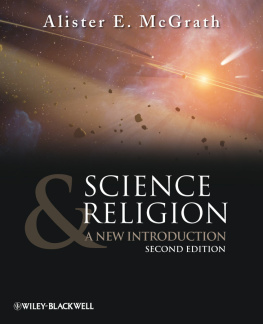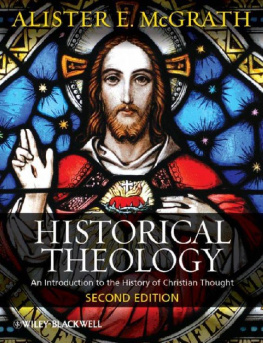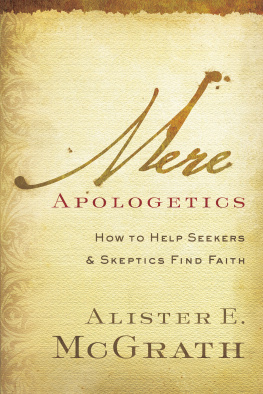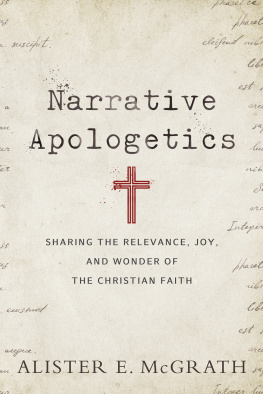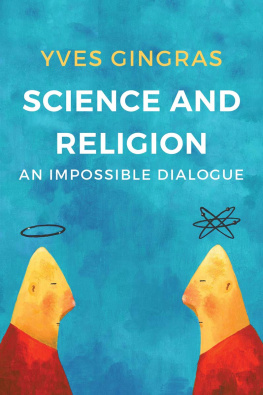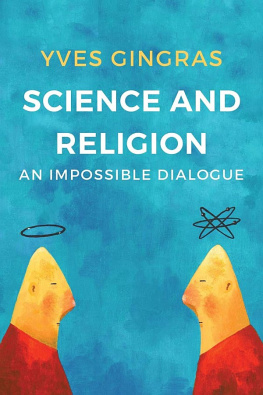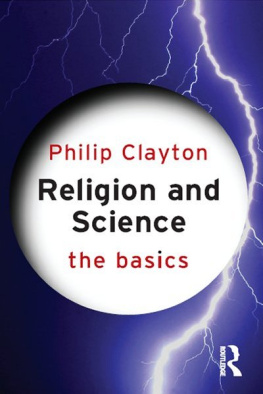
This second edition first published 2010
2010 Alister E McGrath
Edition history: Blackwell Publishers Ltd (1e, 1999)
Blackwell Publishing was acquired by John Wiley & Sons in February 2007. Blackwells publishing program has been merged with Wileys global Scientific, Technical, and Medical business to form Wiley-Blackwell.
Registered Office
John Wiley & Sons Ltd, The Atrium, Southern Gate, Chichester, West Sussex, PO19 8SQ, United Kingdom
Editorial Offices
350 Main Street, Malden, MA 02148-5020, USA
9600 Garsington Road, Oxford, OX4 2DQ, UK
The Atrium, Southern Gate, Chichester, West Sussex, PO19 8SQ, UK
For details of our global editorial offices, for customer services, and for information about how to apply for permission to reuse the copyright material in this book please see our website at www.wiley.com/wiley-blackwell.
The right of Alister E McGrath to be identified as the author of this work has been asserted in accordance with the Copyright, Designs and Patents Act 1988.
All rights reserved. No part of this publication may be reproduced, stored in a retrieval system, or transmitted, in any form or by any means, electronic, mechanical, photocopying, recording or otherwise, except as permitted by the UK Copyright, Designs and Patents Act 1988, without the prior permission of the publisher.
Wiley also publishes its books in a variety of electronic formats. Some content that appears in print may not be available in electronic books.
Designations used by companies to distinguish their products are often claimed as trademarks. All brand names and product names used in this book are trade names, service marks, trademarks or registered trademarks of their respective owners. The publisher is not associated with any product or vendor mentioned in this book. This publication is designed to provide accurate and authoritative information in regard to the subject matter covered. It is sold on the understanding that the publisher is not engaged in rendering professional services. If professional advice or other expert assistance is required, the services of a competent professional should be sought.
Library of Congress Cataloging-in-Publication Data
McGrath, Alister E., 1953
Science and religion: an introduction / Alister E. McGrath. 2nd ed.
p. cm.
Includes bibliographical references and index.
ISBN 978-1-4051-8790-9 (hardcover: alk. paper) ISBN 978-1-4051-8791-6 (pbk.: alk. paper)
1. Religion and science. I. Title.
BL240.3.M44 2010
201.66--dc22
2009020180
A catalogue record for this book is available from the British Library.
Preface
The study of science and religion is one of the most fascinating areas of human inquiry. It brings together two of the most significant forces in contemporary society. The remarkable surge in books and television documentaries dealing with God and physics, spirituality and science, and the great mysteries of human nature and destiny are a clear sign that there is growing interest in this area. Many colleges, seminaries, and universities now offer courses dealing with the general theme of science and religion, which often attract large and appreciative audiences.
Yet there is a problem here. To make sense of the dialogue between sciences and religion, it is necessary to know something about both. A major difficulty facing the field of science and religion studies concerns the extent of prior knowledge of those interested in this area of study. To appreciate the complex interaction of the natural sciences and religion, it is necessary to have at least a good general working knowledge of at least one religion and one major natural science, preferably physics or biology. Many of those who would like to explore this fascinating field find themselves discouraged through this lack of prior knowledge.
This book aims to deal with this situation by assuming that its readers know little, if anything, about the natural sciences or religion, and aims to introduce everything on the basis of the assumption of very limited knowledge on the part of its readers. The main themes and issues in the study of religion and the natural sciences are carefully explored and explained without making unrealistic assumptions about what its readers are likely to know already. Those with some previous knowledge in the areas of science or religion will therefore find that they are from time to time presented with material with which they are already familiar. It is hoped that this will not prove tedious. In any case, the particular concern of this volume is to explore the interface of science and religion. Those who already have some knowledge of science or religion should therefore find that material with which they are already familiar is handled in new ways, so that its connections with our theme become clear.
My own interest in this field goes back for more than 30 years. I began my studies at Oxford University in 1971 by studying chemistry, focusing on quantum theory, before going on to gain my doctorate in molecular biophysics. After this, I studied theology at both Oxford and Cambridge Universities, focusing particularly on the historical interaction of science and religion, particularly during the sixteenth and nineteenth centuries. It is my hope that my own experience of relating the two areas of study may be of value to others seeking to do the same.
This work represents a major revision of the first edition of this work, which benefited considerably from the feedback of its many users. It is hoped that this second edition represents an improvement on its predecessor, both in terms of the scope and level of its coverage. Both the author and publisher welcome comments and criticism, which will be of value to them in developing future editions of this work.
Alister E. McGrath
Kings College, London
January, 2009
How To Use This Book
This book is an introduction to the dialogue between science and religion. It assumes that you know little, if anything, about either science or religion, and sets out to explore this exciting and important field as if you were encountering it for the very first time.
This emphasis on accessibility means that this book includes lots of explanatory material that you will not find in other works of this kind. Years of teaching experience have helped me to realize that students who are new to this field often need far more help than is often appreciated. All the material that is included in this volume has been tested on students and modified to make sure it is easily understood. You should find that you are able to cope with the entire book without undue difficulty, even if you have relatively little scientific or religious background knowledge.
Some readers who already have a background in relevant fields may find that they can skip sections, or read them through very quickly. Yet they may find that other sections introduce them to material which they have not come across before, and will welcome the entry-level introduction to those areas that this work provides.
This book is an introduction, not a comprehensive textbook. It is a starting point for your exploration of the field, but it cannot hope to deal with the questions raised in detail. Its discussions of complex issues such as the nature of realism must be seen as opening the door to further reflection. They are intended to help you become familiar with issues, but cannot deal with them in depth. For this reason, each chapter includes a short list of suitable works for further reading, which will be helpful and accessible to readers who wish to take their thinking further.
Next page
